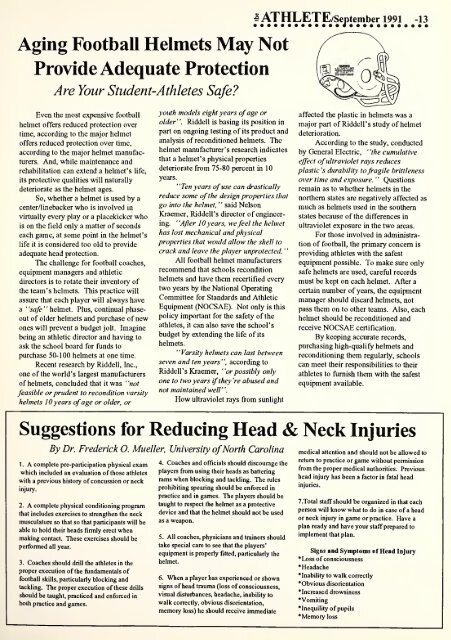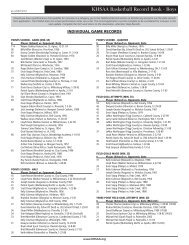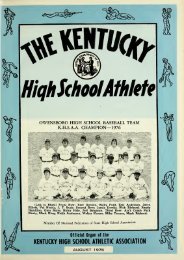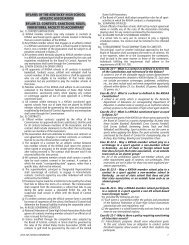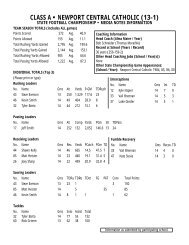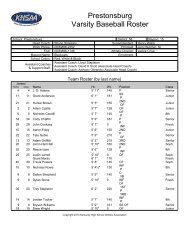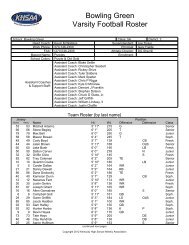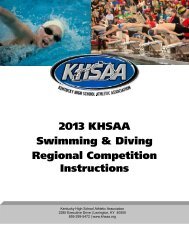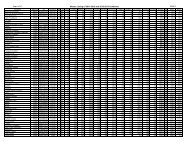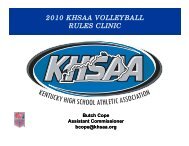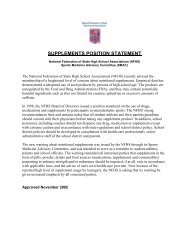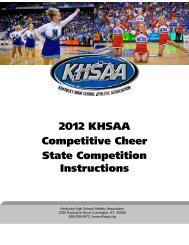Athlete, The - Kentucky High School Athletic Association
Athlete, The - Kentucky High School Athletic Association
Athlete, The - Kentucky High School Athletic Association
You also want an ePaper? Increase the reach of your titles
YUMPU automatically turns print PDFs into web optimized ePapers that Google loves.
'.<br />
Aging Football Helmets May Not<br />
Provide Adequate Protection<br />
Are Your Student-<strong>Athlete</strong>s Safe?<br />
ATHLETE/September 1991 -13<br />
I<br />
Even the most expensive football<br />
helmet offers reduced protection over<br />
time, according to the major helmet<br />
offers reduced protection over time,<br />
according to the major helmet manufacturers.<br />
And, while maintenance and<br />
rehabilitation can extend a helmet's Ufe,<br />
its protective qualities will naturally<br />
deteriorate as the helmet ages.<br />
So, whether a helmet is used by a<br />
center/linebacker who is involved in<br />
virtually every play or a placekicker who<br />
is on the field only a matter of seconds<br />
each game, at some point in the helmet's<br />
life it is considered too old to provide<br />
adequate head protection.<br />
<strong>The</strong> challenge for football coaches,<br />
equipment managers and athletic<br />
directors is to rotate their inventory of<br />
the team's helmets. This practice will<br />
assure that each player will always have<br />
a ' 'safe ' ' helmet. Plus, continual phaseout<br />
of older helmets and purchase of new<br />
ones will prevent a budget joU. Imagine<br />
being an athletic director and having to<br />
ask the school board for funds to<br />
purchase 50-100 helmets at one time.<br />
Recent research by Riddell, Inc.,<br />
one of the world's largest manufacturers<br />
of helmets, concluded that it was "not<br />
feasible or prudent to recondition varsity<br />
helmets 10 years of age or older, or<br />
youth models eight years of age or<br />
older".<br />
Riddell is basing its position in<br />
part on ongoing testing of its product and<br />
analysis of reconditioned hehnets. <strong>The</strong><br />
helmet manufacturer's research indicates<br />
that a helmet's physical properties<br />
deteriorate from 75-80 percent in 1<br />
years.<br />
'<br />
'Ten years of use can drastically<br />
reduce some of the design properties that<br />
go into the helmet, ' ' said Nelson<br />
Kraemer, Riddell's director of engineering.<br />
"After 10 years, we feel the helmet<br />
has lost mechanical and physical<br />
properties that would allow the shell to<br />
crack and leave the player unprotected.<br />
All football helmet manufacturers<br />
recommend that schools recondition<br />
helmets and have them recertified every<br />
two years by the National Operating<br />
Committee for Standards and <strong>Athletic</strong><br />
Equipment (NOCSAE). Not only is this<br />
policy important for the safety of the<br />
athletes, it can also save the school's<br />
budget by extending the life of its<br />
helmets.<br />
"Varsity helmets can last between<br />
se\'en and ten years ' ', according to<br />
Riddell's Kraemer, "or possibly only<br />
one to two years if they 're abused and<br />
not maintained well '<br />
How ultraviolet rays from sunlight<br />
affected the plastic in helmets was a<br />
major part of Riddell's study of helmet<br />
deterioration.<br />
According to the study, conducted<br />
by General Electric,<br />
'<br />
'the cumulative<br />
effect of ultraviolet rays reduces<br />
plastic 's durability tofragile brittleness<br />
over time and exposure. " Questions<br />
remain as to whether helmets in the<br />
northern states are negatively affected as<br />
much as helmets used in the southern<br />
states because of the differences in<br />
ultraviolet exposure in the two areas.<br />
For those involved in administration<br />
of football, the primary concern is<br />
providing athletes with the safest<br />
equipment possible. To make sure only<br />
safe helmets are used, careful records<br />
must be kept on each helmet. After a<br />
certain number of years, the equipment<br />
manager should discard helmets, not<br />
pass them on to other teams. Also, each<br />
helmet should be reconditioned and<br />
receive NOCSAE certification.<br />
By keeping accurate records,<br />
purchasing high-qualify helmets and<br />
reconditioning them regularly, schools<br />
can meet their responsibilities to their<br />
athletes to furnish them with the safest<br />
equipment available.<br />
Suggestions for Reducing Head & Neck Injuries<br />
By Dr. Frederick O. Mueller, University ofNorth Carolina<br />
1. A complete pre-participation physical exam<br />
which included an evaluation of those athletes<br />
with a previous history of concussion or neck<br />
injury.<br />
2. A complete physical conditioning program<br />
that includes exercises to strengthen the neck<br />
musculature so that so that participants will be<br />
able to hold their heads firmly erect when<br />
making contact.<br />
performed all year.<br />
<strong>The</strong>se exercises should be<br />
3. Coaches should drill the athletes in the<br />
proper execution of the fundamentals of<br />
football skills, particularly blocking and<br />
tackling.<br />
<strong>The</strong> proper execution of these drills<br />
should be taught, practiced and enforced in<br />
both practice and games.<br />
4. Coaches and officials should discourage the<br />
players from using their heads as battering<br />
rams when blocking and tackling.<br />
<strong>The</strong> rules<br />
prohibiting spearing should be enforced in<br />
practice and in games. <strong>The</strong> players should be<br />
taught to respect the helmet as a protective<br />
device and that the helmet should not be used<br />
as a weapon.<br />
5. All coaches, physicians and trainers should<br />
take special care to see that the players'<br />
equipment is properiy filled, particularly the<br />
helmet.<br />
6. When a player has experienced or shown<br />
signs of head trauma (loss of consciousness,<br />
visual disturbances, headache, inability to<br />
walk correctly, obvious disorientation,<br />
memory loss) he should receive immediate<br />
medical attention and should not be allowed to<br />
return to practice or game without permission<br />
from the proper medical authorities.<br />
Previous<br />
head injury has been a factor in fatal head<br />
injuries.<br />
7.Total staff should be organized in that each<br />
person will know what (o do in case of a head<br />
or neck injury in game or practice. Have a<br />
plan ready and have your staff prepared to<br />
implement that plan.<br />
Signs and Symptoms or Head Injury<br />
•Loss of consciousness<br />
•Headache<br />
•Inability to walk correctly<br />
•Obvious disorientation<br />
•Increased drowsiness<br />
•Vomiting<br />
•Inequlllty of pupils<br />
•Memory loss


